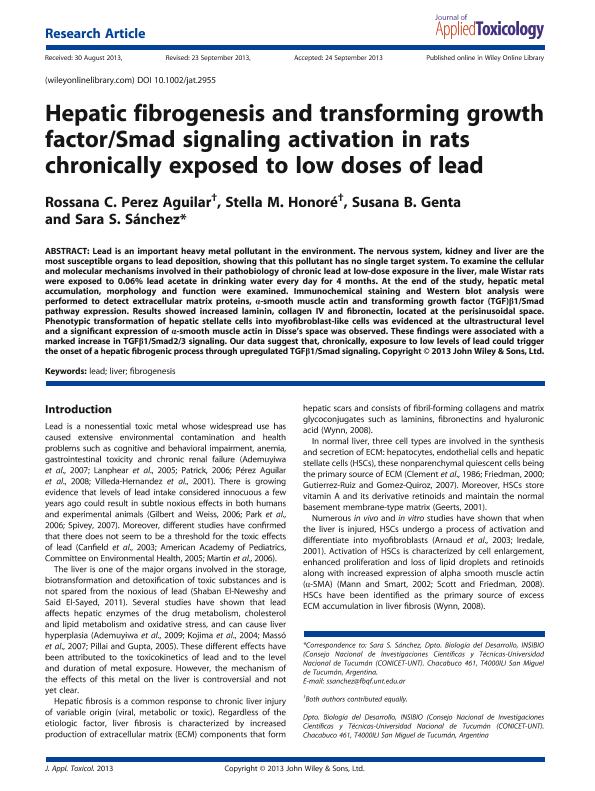Artículo
Hepatic fibrogenesis and transforming growth factor/Smad signaling activation in rats chronically exposed to low doses of lead
Pérez Aguilar, Rossana Cristina; Honore, Stella Maris ; Genta, Susana Beatriz de Fátima; Sanchez, Sara Serafina del V.
; Genta, Susana Beatriz de Fátima; Sanchez, Sara Serafina del V.
 ; Genta, Susana Beatriz de Fátima; Sanchez, Sara Serafina del V.
; Genta, Susana Beatriz de Fátima; Sanchez, Sara Serafina del V.
Fecha de publicación:
11/2013
Editorial:
Wiley
Revista:
Journal of Applied Toxicology
ISSN:
0260-437X
Idioma:
Inglés
Tipo de recurso:
Artículo publicado
Clasificación temática:
Resumen
Lead is an important heavy metal pollutant in the environment. The nervous system, kidney and liver are the most susceptible organs to lead deposition, showing that this pollutant has no single target system. To examine the cellular and molecular mechanisms involved in their pathobiology of chronic lead at low-dose exposure in the liver, male Wistar rats were exposed to 0.06% lead acetate in drinking water every day for 4 months. At the end of the study, hepatic metal accumulation, morphology and function were examined. Immunochemical staining and Western blot analysis were performed to detect extracellular matrix proteins, α-smooth muscle actin and transforming growth factor (TGF)β1/Smad pathway expression. Results showed increased laminin, collagen IV and fibronectin, located at the perisinusoidal space. Phenotypic transformation of hepatic stellate cells into myofibroblast-like cells was evidenced at the ultrastructural level and a significant expression of α-smooth muscle actin in Disse's space was observed. These findings were associated with a marked increase in TGFβ1/Smad2/3 signaling. Our data suggest that, chronically, exposure to low levels of lead could trigger the onset of a hepatic fibrogenic process through upregulated TGFβ1/Smad signaling.
Palabras clave:
Lead
,
Liver
,
Fibrogenesis
,
Tgf/Smad Signaling
Archivos asociados
Licencia
Identificadores
Colecciones
Articulos(INSIBIO)
Articulos de INST.SUP.DE INVEST.BIOLOGICAS
Articulos de INST.SUP.DE INVEST.BIOLOGICAS
Citación
Sanchez, Sara Serafina del V.; Genta, Susana Beatriz de Fátima; Honore, Stella Maris; Pérez Aguilar, Rossana Cristina; Hepatic fibrogenesis and transforming growth factor/Smad signaling activation in rats chronically exposed to low doses of lead; Wiley; Journal of Applied Toxicology; 34; 12; 11-2013; 1320-1331
Compartir
Altmétricas



